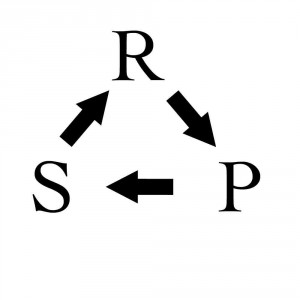New Discovery in the Game Theory of Rock-Paper-Scissors
The game of Rock-Paper-Scissors is always the classic example of a zero sum game. It has a mixed strategy Nash equilibrium of choosing each action a third of the time. It turns out that this is the best strategy. Over the long run, the Nash Equilibrium Strategy makes it equally likely that you will win, tie, or lose, and thus you would be indifferent between any possible alternatives.
That is how the game is generally believed to be like, proved by various small scale experiments. However, researchers from Zhejiang University in China discovered that there is more than the simple randomized strategies in this game. Their experiment indicates that the strategy of real players looks random on average but actually consists of predictable patterns which were the result of human psychology.
The researchers conducted their experiments with 360 students recruited from Zhejiang University and divided into 60 groups of six players. In each group, the players played 300 rounds of Rock-Paper-Scissors against each other. Researchers carefully recorded the results and the participants’ behavior.
The results shows that on average, the players in all the groups chose each action approximately a third of the time, which is not surprising since they were expected to choose randomly. But a closer inspection of their behavior reveals something else: players who win tend to stick with the same action while those who lose switch to the next action in a clockwise direction, as shown in the image below.

This is known in game theory as a Conditional Response and has never been observed before in Rock-Paper-Scissors experiments, probably because previous experiments have all been done on a much smaller scale.
“This game exhibits collective cyclic motions which cannot be understood by the Nash Equilibrium concept but are successfully explained by the empirical data-inspired conditional response mechanism,” as claimed by the researchers.
By looking at the results reveled by the experiments, we can develop the true dominant strategy that may lead you to victory in the Rock-Paper-Scissors games.
- The first strategy is the countertactic. Let’s say you played scissors and your opponent played rock. The chance that your opponent will confidently play rock again is now very high. What that means to you: anticipate that and play paper. In other words: play the option that wasn’t played in the previous round.
- The second strategy is to mirror. If you just won, play what your opponent just played, because he or she will think that you are going to play the same gesture again.
This kind of “win-stay, lose-shift” strategy is entirely plausible from a psychological point of view: people tend to stick with a winning strategy. The theoretical calculations in the experiment reveal that this new strategy may offer higher payoffs to individual players in comparison with the Nash Equilibrium mixed strategy.
The researchers in Zhejiang University hope to investigate this psychological aspect in more detail in future studies. An interesting question is how this kind of response is “built in” to the brain. “Whether conditional response is a basic decision-making mechanism of the human brain or just a consequence of more fundamental neural mechanisms is a challenging question for future studies,” they say.
Reference:
http://arxiv.org/abs/1404.5199 : Social Cycling And Conditional Responses In The Rock-Paper-Scissors Game
http://www.technologyreview.com/view/527026/how-to-win-at-rock-paper-scissors/#comments
http://motherboard.vice.com/read/game-theory-rock-paper-scissors
